Dairy-free Coconut Panna Cotta served with an assortment of tropical fruits and a sprinkling of Filipino latik topping!
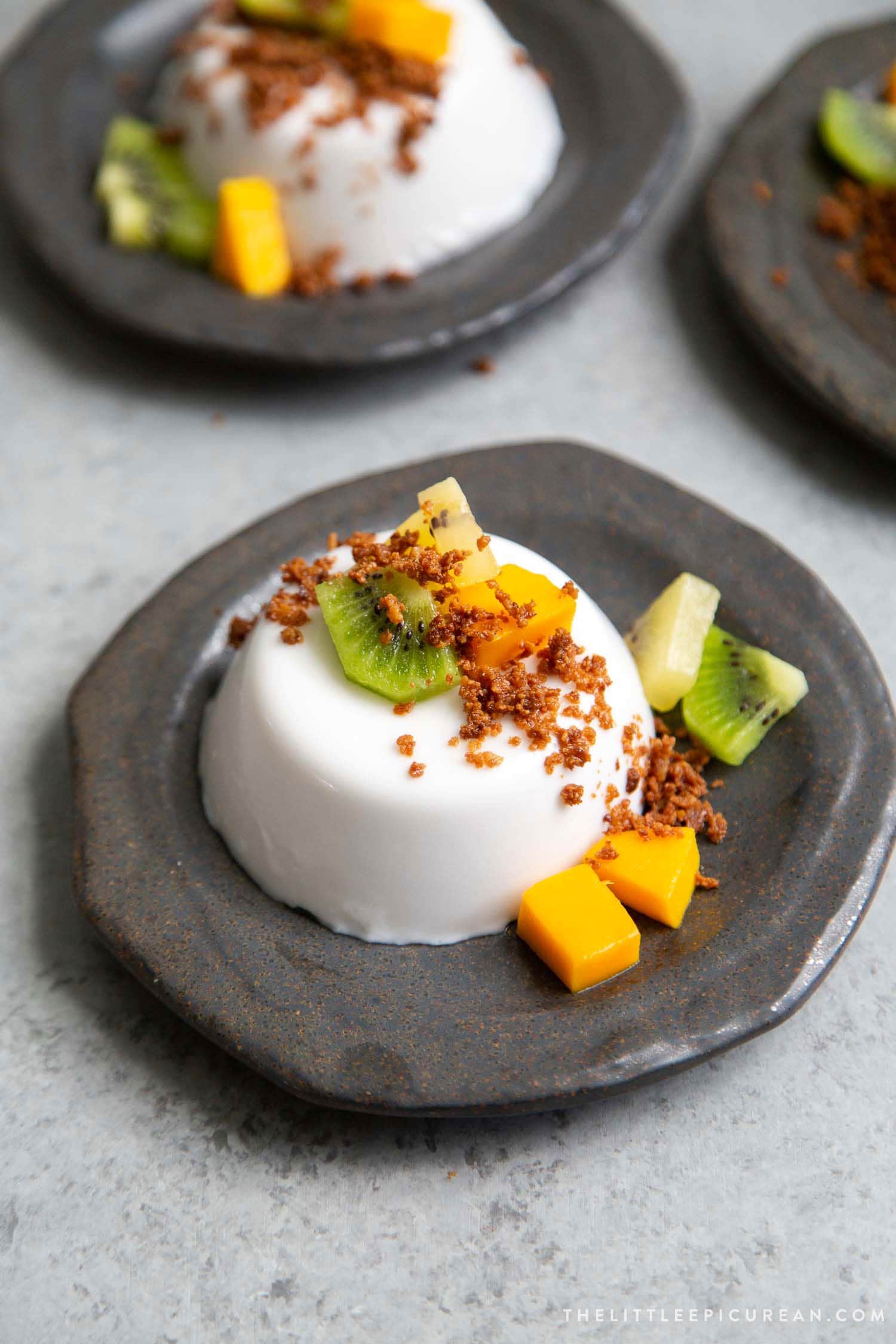
Impress dinner guests with this plated dessert! It’s quick and easy to make.
Yet, it looks worthy of a fine dining restaurant!
Best of all, panna cotta can be prepared ahead of time.
It keeps well in the fridge, making it perfect for dinner parties, brunch gatherings, and upcoming holiday celebrations.
This isn’t your standard milk and cream panna cotta. This version has a tropical twist!
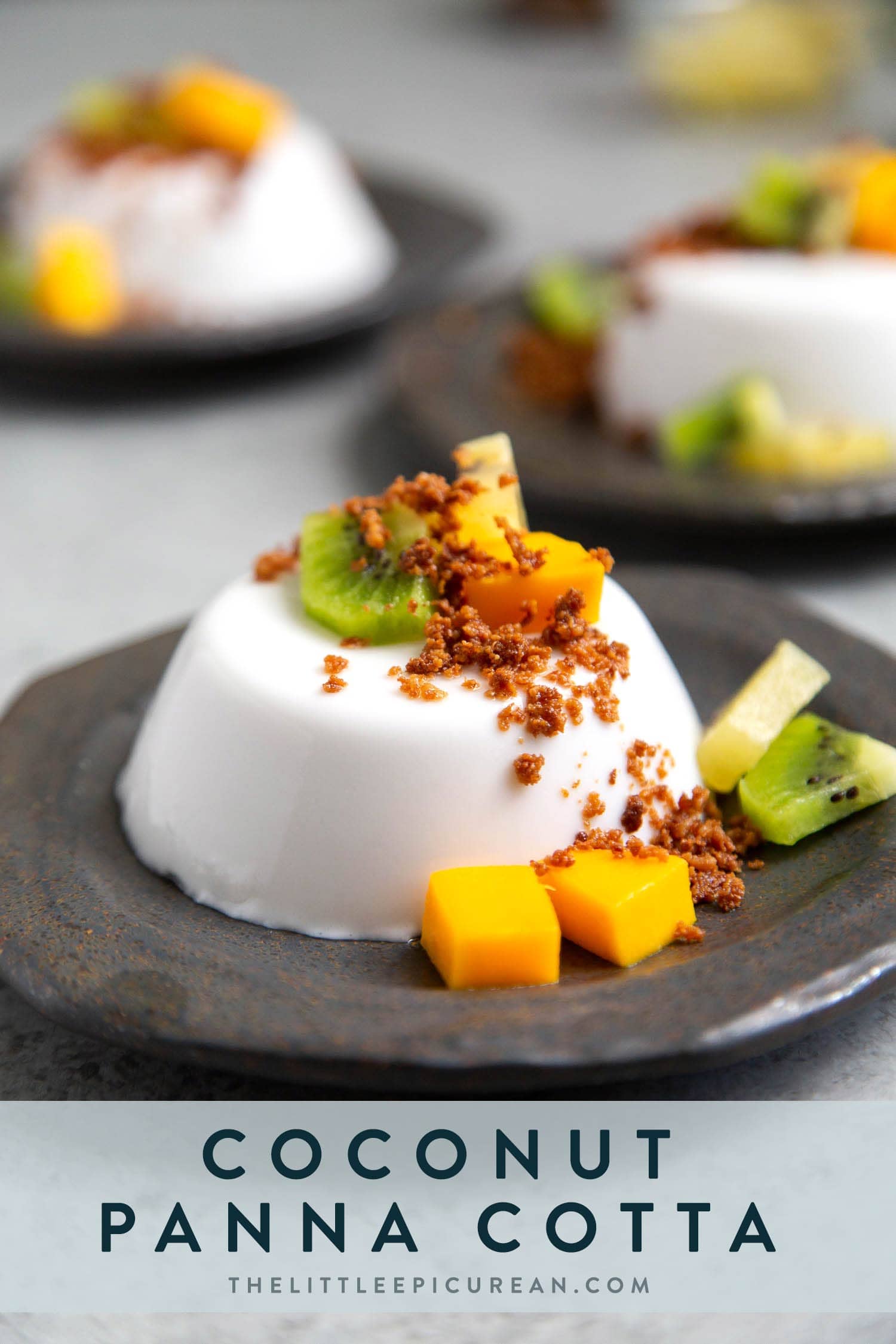
Table of Contents
What is Panna Cotta?
Panna cotta is Italian for “cooked cream.”
It is an easy dessert simply made by cooking together milk, cream, and gelatin.
This dairy-free Panna Cotta is made from a mixture of coconut milk, coconut cream, sugar and gelatin.
Ingredients for Coconut Panna Cotta:
- Coconut milk
- Coconut Cream
- Granulated sugar (or coconut sugar!)
- Gelatin
Coconut Milk
Use full-fat canned unsweetened coconut milk. Check the label to ensure the first ingredient is coconut.
Do not use light coconut milk or reduced fat coconut milk.
Stay away from refrigerated coconut milk sold in cartons. These lighter coconut milks will not produce the same creamy results.
*If you’re lucky enough to live in an area with fresh coconuts, making your own coconut milk/cream would be the best and tastiest option!
Coconut Cream
Use canned unsweetened coconut cream, where coconut is the first ingredient.
Do not use “cream of coconut.” It’s full of sugar!
Cream of coconut is better suited for mixing cocktails like Pina Colada.
To scale back on fat, you may omit the coconut cream and use all coconut milk.
Granulated Sugar
Use plain white granulated sugar to achieve that super white coconut Panna Cotta photographed in this post.
Raw sugar (unbleached sugar) or coconut sugar will slightly tint the mixture.
Gelatin
This recipe uses powdered unflavored gelatin.
Gelatin is made from animal collagen.
It’s used to make jello and gummy snacks, as well as thicken mousses and marshmallows.
Use agar (agar-agar) for a vegan alternative.
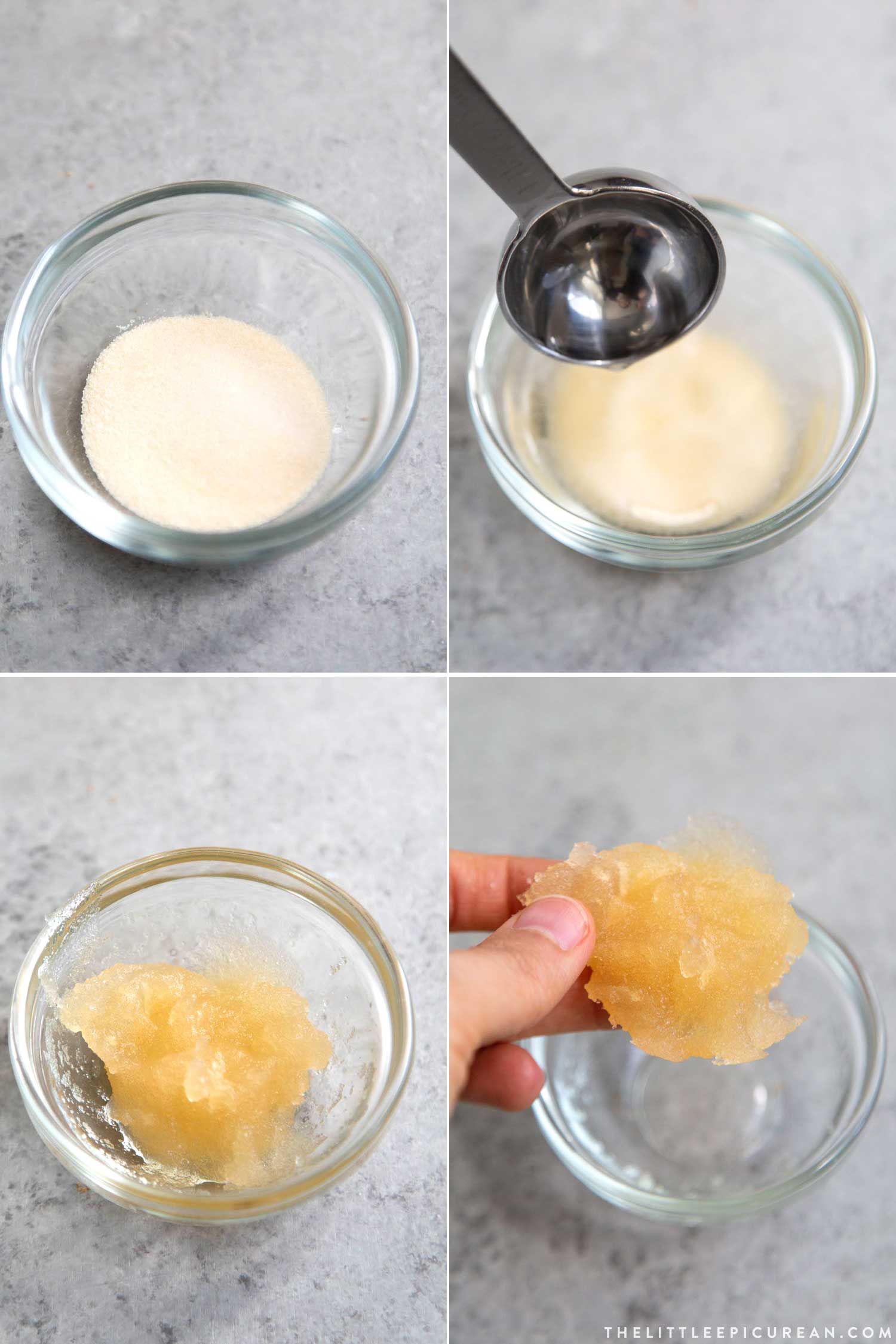
How to work with powdered gelatin:
Gelatin must first be “bloomed.”
This step is important regardless of whether you are using gelatin powder, granules, or sheets.
To bloom gelatin, it is mixed together with water.
- Place gelatin powder in a small bowl.
- Add water and mix together.
- Allow gelatin mixture to sit for 5 minutes to soak up moisture.
- Gelatin is ready for the recipe once it has fully absorbed the liquids.
Incorporating Gelatin
Once the gelatin has been hydrated, it is mixed with warm liquids until melted.
Make sure to thoroughly dissolve the gelatin. Otherwise, you may end up with clumps.
The liquid mixture is then placed in the fridge for a few hours to allow the gelatin to “set up.”
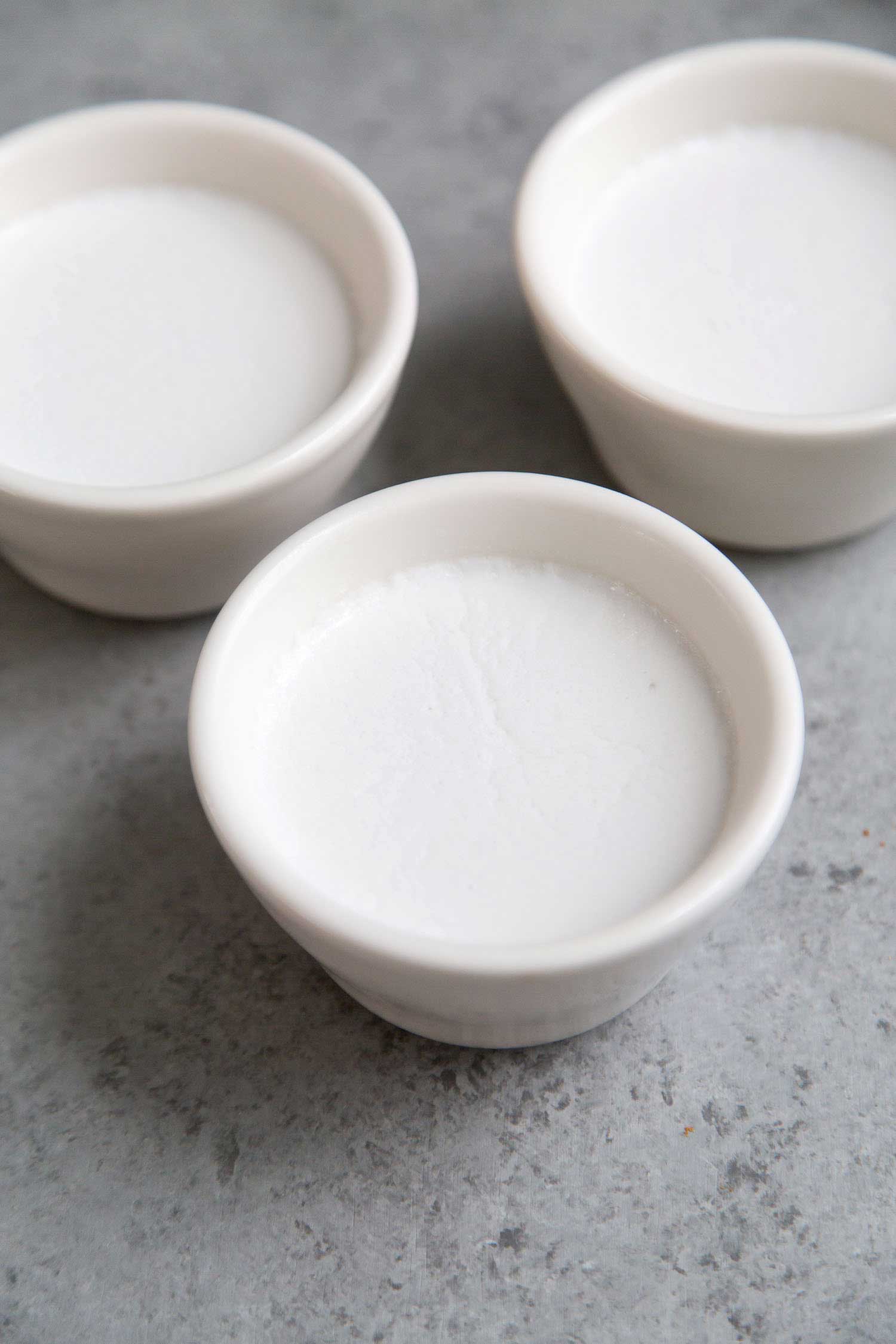
Serving glasses and molds:
Panna Cotta may be served in a variety of different glasses, cups, jars, ramekins, and molds.
It is best to use shapes with clean lines.
The set Panna Cotta can be eaten straight out of the serving vessel, or unmolded and served as a plated dessert.
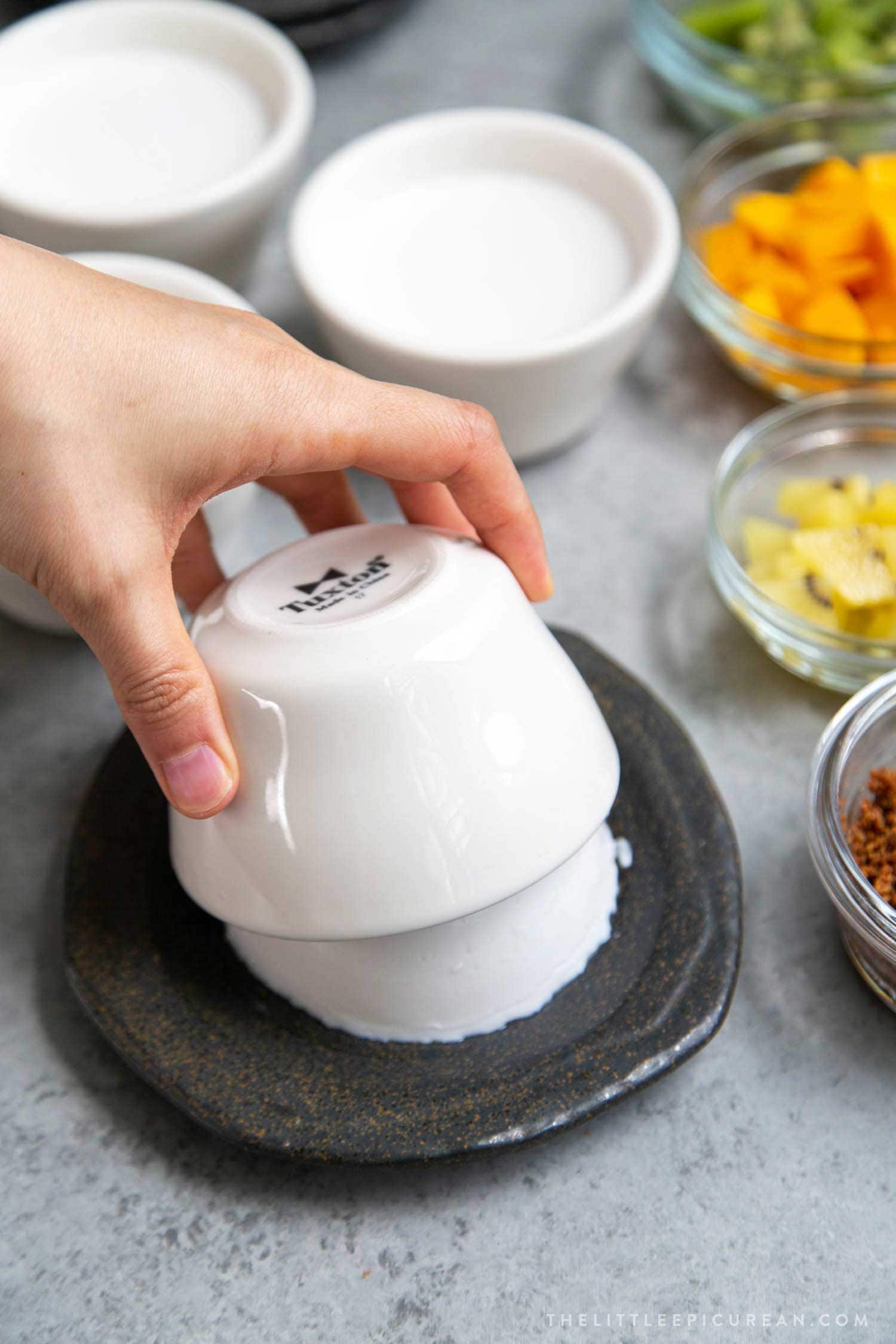
How to unmold:
Use molds with clean lines. This is allow for easier removal.
Take the filled molds out of the refrigerator. Dip the molds in warm water until the panna cotta loosens from the vessel.
Flip the Panna Cotta over onto a plate. It should slide right out.
If not, continue to dip the mold in warm water until the Panna Cotta separates from the sides of the mold.
It’s best to use a vessel with thin walls. Thicker walled vessel with require more soaking.
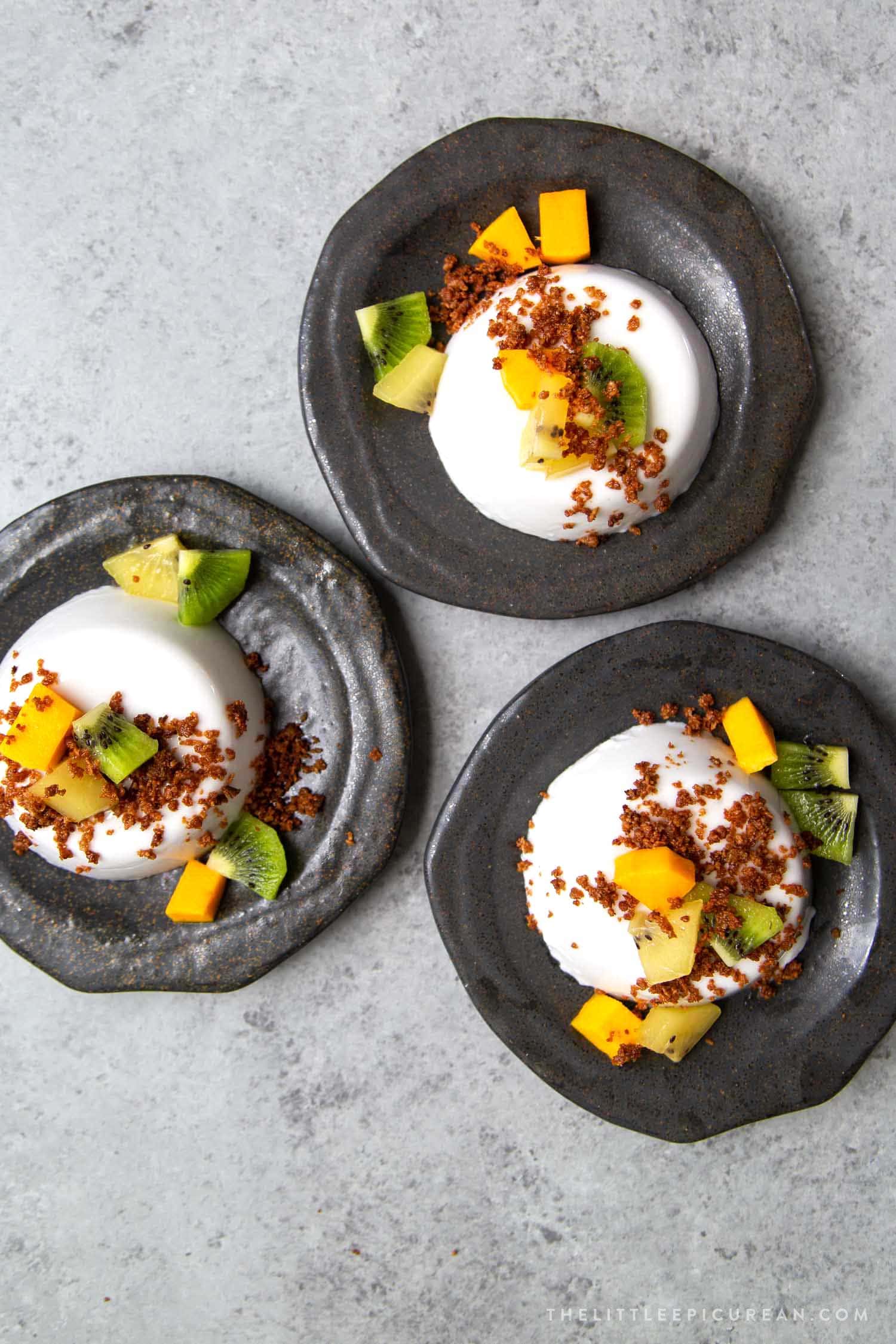
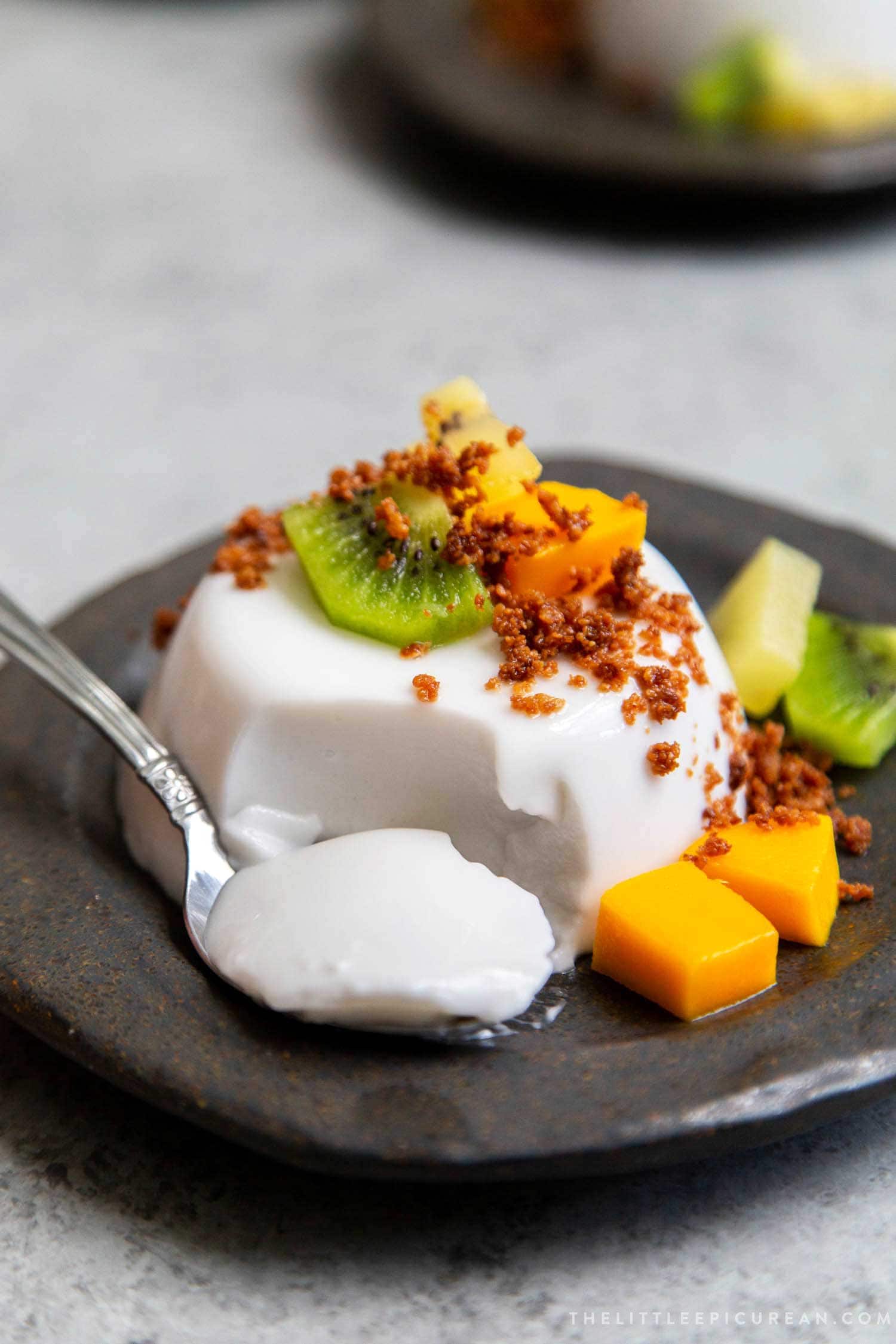
Silky, creamy, and tropical!
This dessert is very rich and creamy. It tastes like coconut ice cream with a super silky texture.
For added texture, shredded coconut or other fruits may be mixed into the Panna Cotta before chilling.
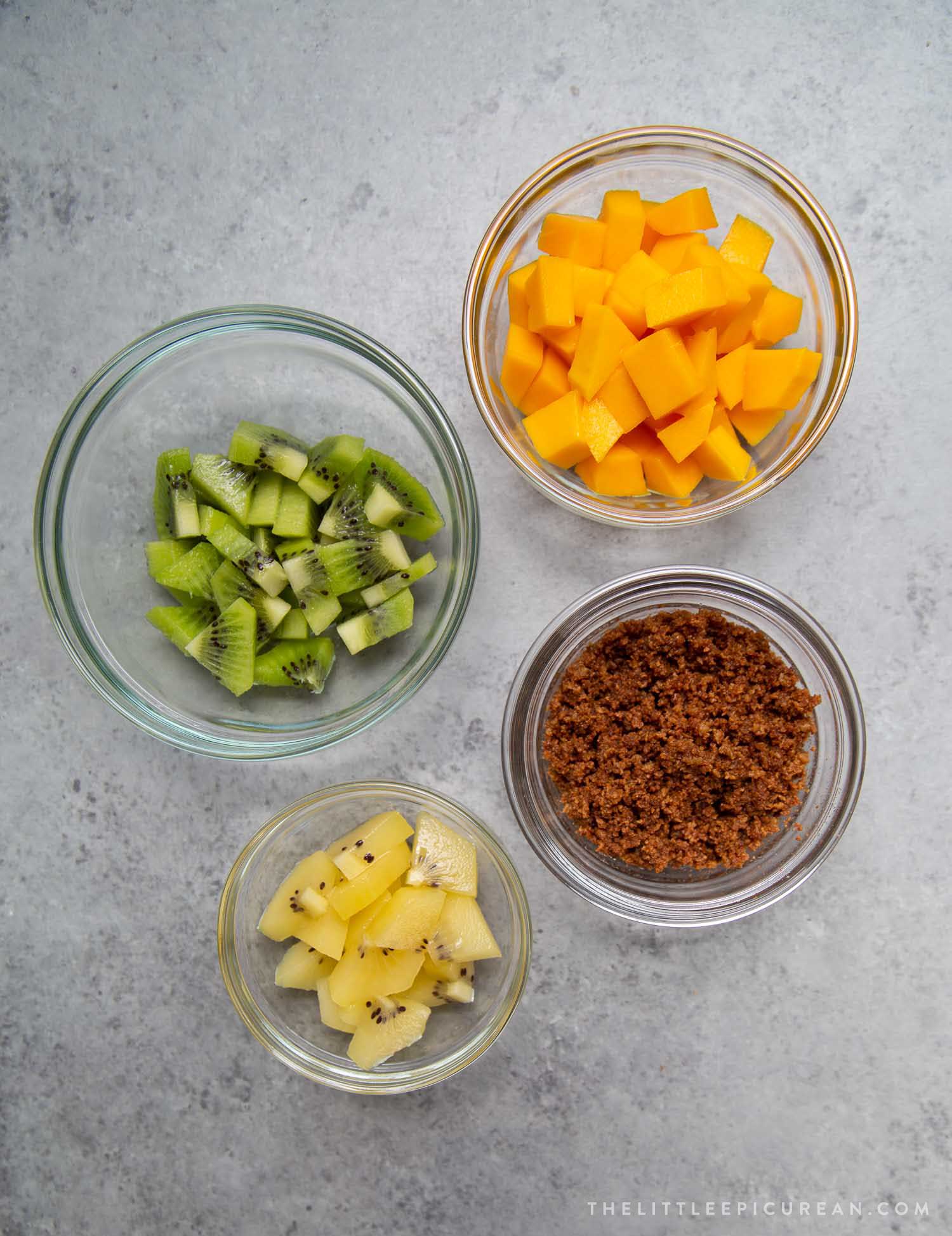
Toppings:
- green and golden kiwi
- mango
- latik
Other tropical fruits that would pair well with coconut include: banana, pineapple, passion fruit, dragon fruit, and guava.
What is latik?
Latik is Tagalog for fried coconut milk curds. It is extensively used in Filipino desserts.
It is a topping commonly sprinkled over Biko (Filipino sticky rice cake) , suman, and sapin-sapin.
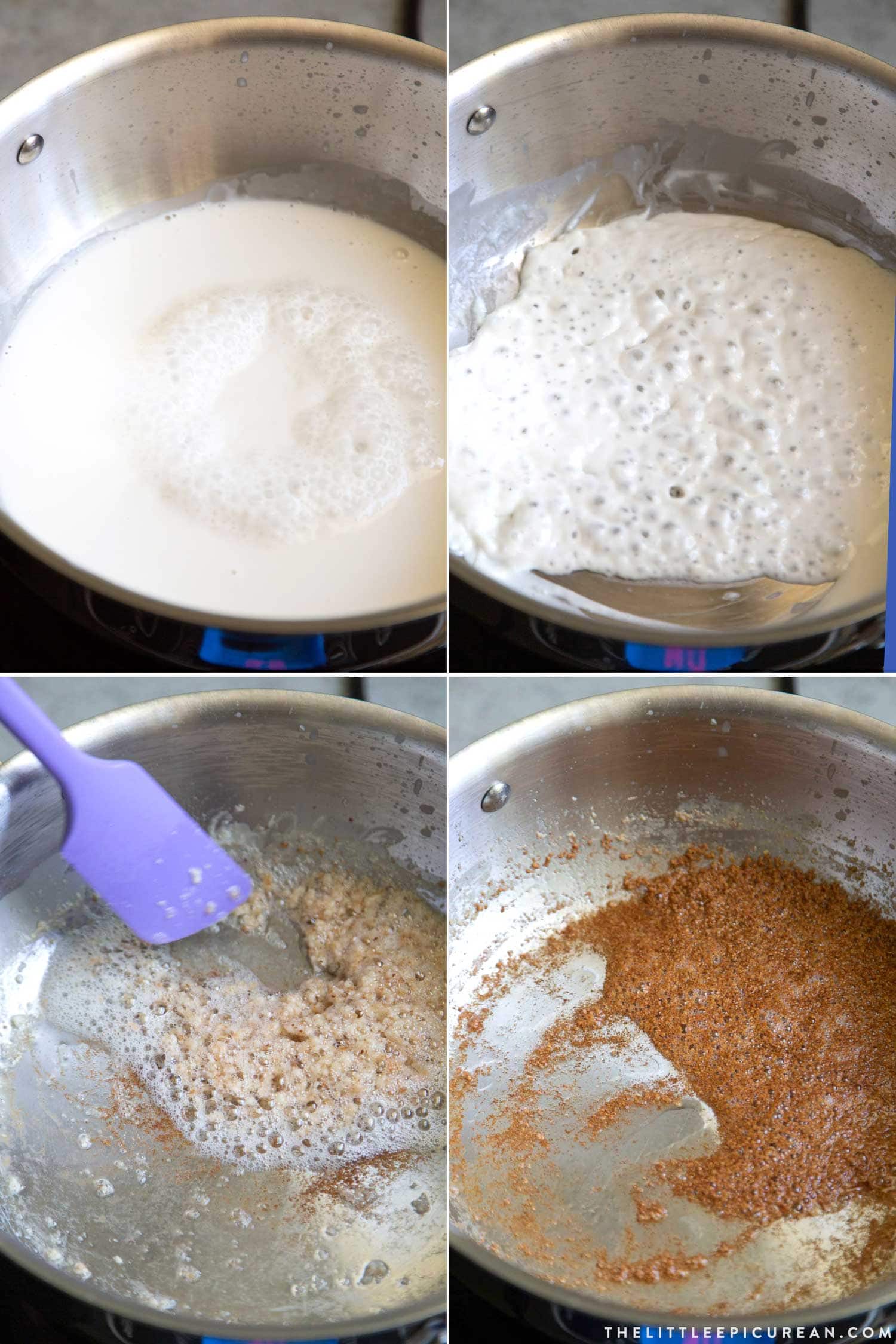
How to make Latik?
Latik is made from coconut milk or coconut cream. It works best with fresh coconut milk.
However, full-fat canned unsweetened coconut milk will yield similar results.
Be sure to use coconut milk that has coconut as the first ingredient.
- Gently heat coconut milk in a shallow pan until it bubbles and simmers.
- Allow the water to evaporate from the coconut milk. The mixture will thicken.
- The coconut oil will separate from the coconut milk solids (milk curds).
- Continue to cook the coconut milk solids until golden brown.
Pour the coconut milk solids and coconut oil into a sieve lined with a coffee filter.
Allow the coconut oil to drip and separate from the latik.
Save the coconut oil for future cooking or baking. Use the latik immediately, or keep in the fridge for longer storage.
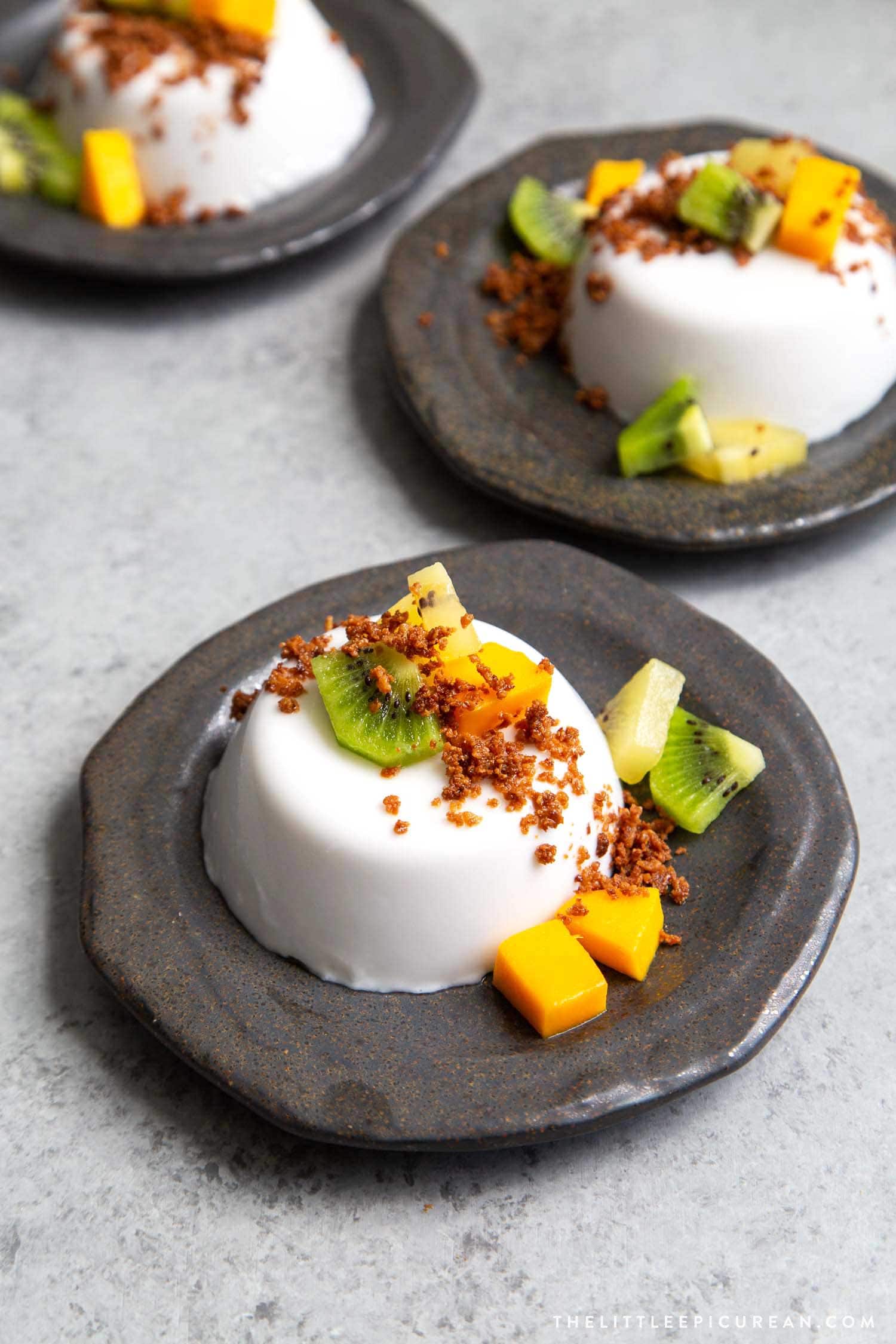
Storage and Leftovers:
Coconut panna cotta may be cooked ahead of time. The chilled panna cotta will keep in the fridge for up to 4 days.
Keep panna cotta covered or store in an airtight container to prevent it from absorbing any unwanted flavors from the fridge.
Serve coconut Panna Cotta cold. If left out at room temperature for too long, the panna cotta will loosen.
Coconut Panna Cotta
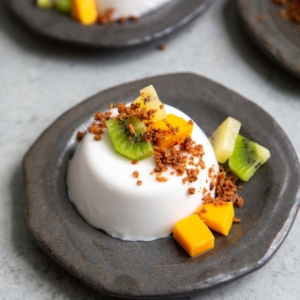
Ingredients
Coconut Panna Cotta:
- 0.25 oz packet unflavored gelatin powder,, about 1 Tablespoon
- 1 Tablespoon water
- 2 ¼ cup canned full-fat unsweetened coconut milk
- ¾ cup canned unsweetened coconut cream
- ¼ cup granulated sugar
Latik:
- 1 – 14 oz canned unsweetened coconut cream, , or coconut milk
Additional Toppings:
- golden kiwi
- green kiwi
- mango
Instructions
Coconut Panna Cotta:
- Grease ramekins or serving vessels with coconut oil. Set aside.
- In a small bowl, combine gelatin powder with water. Stir and let sit for 5 minutes until moisture has been fully absorbed.
- In a medium sauce pot, combine coconut milk, coconut cream, and sugar. Set over medium heat and bring to a simmer. Continue to heat until sugar has dissovled. Remove from heat and allow to cool 5-8 minutes.
- Add in gelatin. Stir until gelatin has completely dissolved.
- Divide milk mixture among prepared greased ramekins. Cool to room tempeature. Cover or keep in airtight container in the fridge for at least 6 hours, overnight is best.
- To unmold, dip ramekins one a time into a bowl of warm water for 3-5 seconds. The panna cotta should separate from the vessel. If not, dip ramekin again. If panna cotta is still not separating, run a thin knife or mini offset spatula along the edges of ramekin to loosen. Invert ramekin into serving plate. Garnish with toppings and immediately serve.
Latik:
- Pour well shaken coconut milk in a shallow pan. Set over medium heat and bring to a simmer. The mixture will bubble and thicken as the water evaporates from the coconut milk.
- Lower heat and continue to cook until coconut oil separates from the coconut milk curds (coconut milk solids). Stir often to prevent the coconut milk curds from burning.
- Allow the coconut milk curds to fry in the coconut oil. Continue to cook until coconut milk curds are golden brown. Pour coconut milk curds and coconut oil into a sieve lined with coffee filter to separate the coconut oil.
- Store coconut oil in the fridge for later cooking use. Use latik (coconut milk curds) immediately, or store in the fridge for later use.
Notes
Ingredient Notes:
- Use canned full-fat unsweetened coconut milk. Check the label to ensure coconut is the first ingredient.
- Do not use light coconut milk or reduced fat coconut milk. Stay away from refrigerated coconut milk sold in cartons. These lighter coconut milks will not produce the same creamy results.
- Do not use “cream of coconut” in place of coconut cream. They are not the same thing.
- To scale back on fat, you may use all coconut milk and omit the coconut cream.
- Granulated white sugar will result with the bright white Panna Cotta. If you use coconut sugar or raw sugar, the Panna Cotta will be slightly tinted.
Storage and Leftovers:
- Panna Cotta can be stored in the fridge for up to four days.
- Latik can be stored in the fridge in an airtight container for up to a week.
Nutrition
Nutrition information is automatically calculated, so should only be used as an approximation.
 Like this recipe? Rate & comment below!
Like this recipe? Rate & comment below!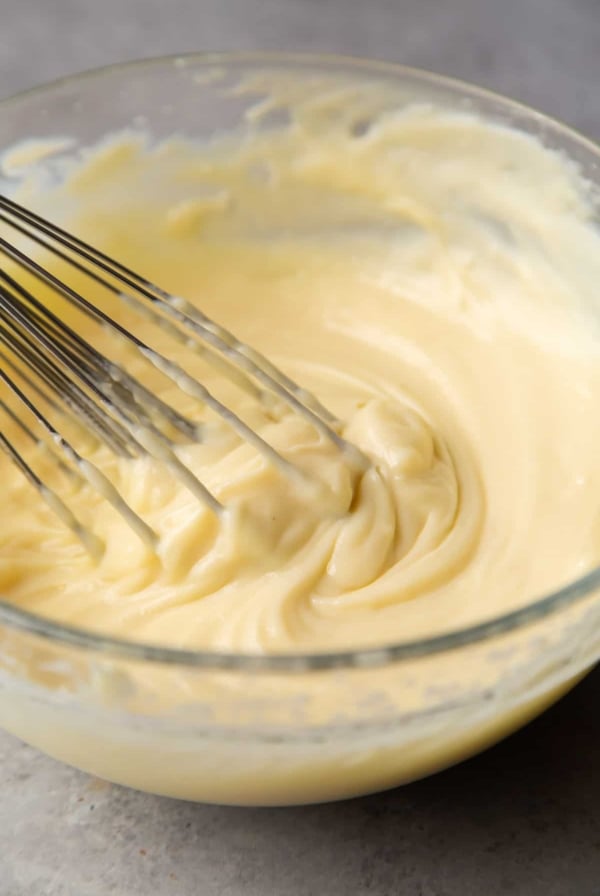
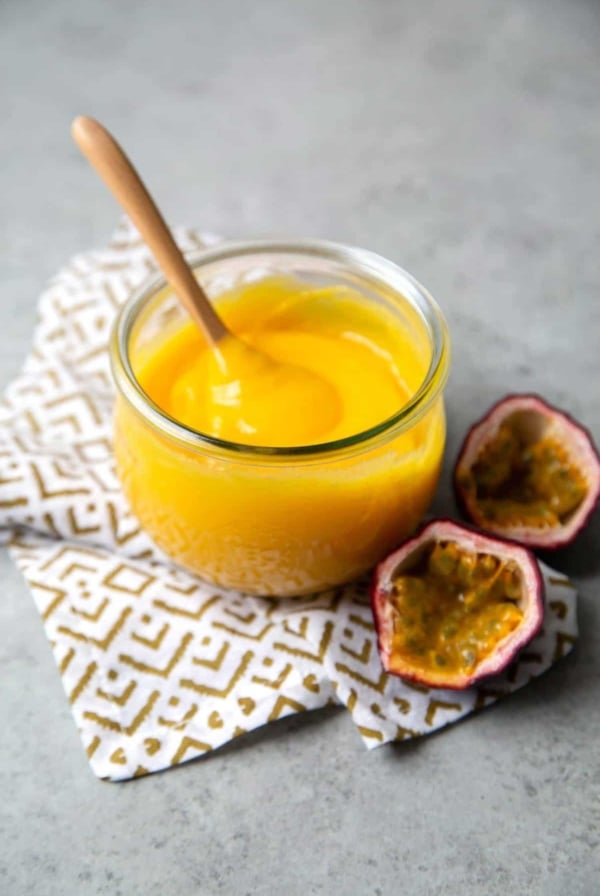
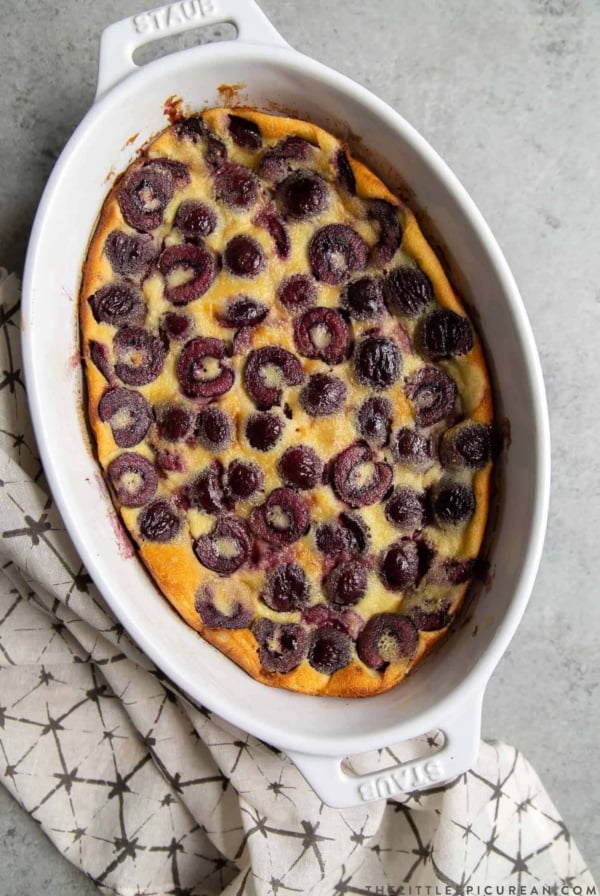
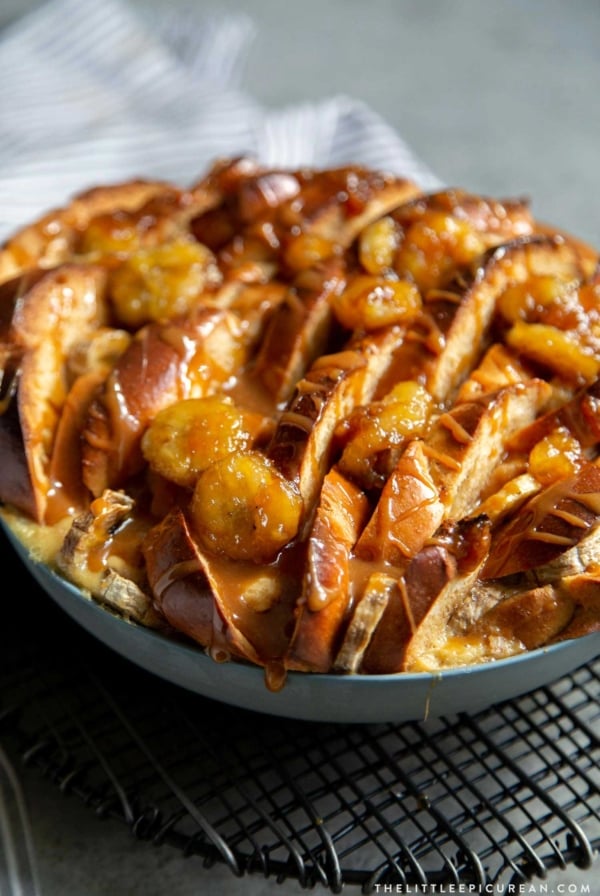





A tablespoon of gelatin? I followed this recipe to the letter and these panna cottas are like rubber. Are you sure there isn’t a typo in this recipe?
We serve this as a sometimes dessert at our restaurant. We love it so much!! Always get many complements!
This recipe was so delicious but mine never set :( The gelatin mixed with water became almost a solid, like a gummy bear, then I’m fairly sure it dissolved but it was way too loose. I think if I added extra it would have been fine. I also used mini muffin tins as this was for a party, and that was probably too little.
Thanks for sharing! Does it keep long?
The chilled panna cotta will keep in the fridge for up to 4 days.
This looks so good! Can I use this base to make other flavors?
Thanks! Coconut milk has a prominent flavor. It would be difficult to cover it up. You’d need a strong flavor to compete with it (like vanilla or cinnamon). I would use regular cow’s milk if you’d like to make other flavors.
What is the volume of the cans of coconut you are using>
Hi! This recipe looks yummy. Where section of the grocery store can I find coconut cream? Or is this the thick stuff that’s in the can of coconut milk?
Canned coconut cream is located next to the canned coconut milk. If you cannot find it, simply sub with additional canned coconut milk.
How many serve are there?
It depends on the size ramekins or serving vessel you use. The recipe makes about 3 cups worth of panna cotta. I divided it between 6 containers.